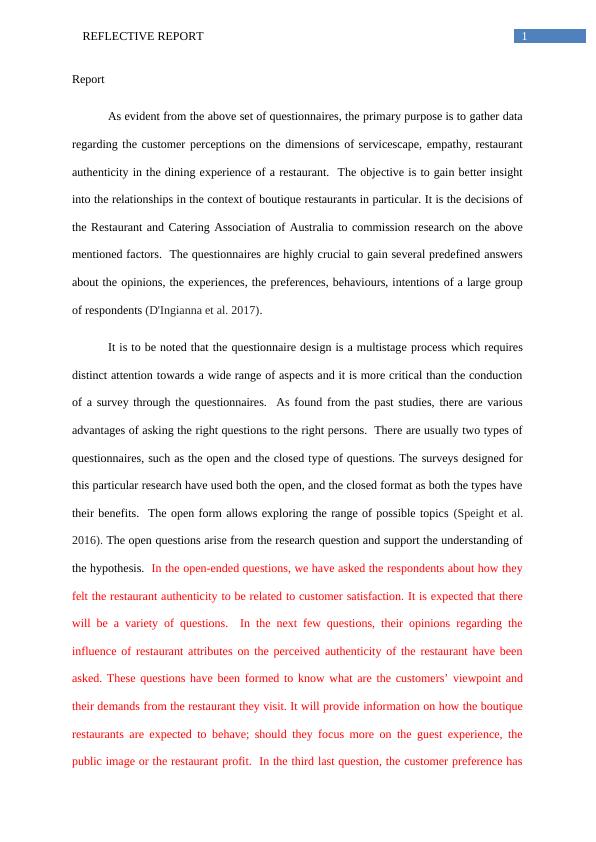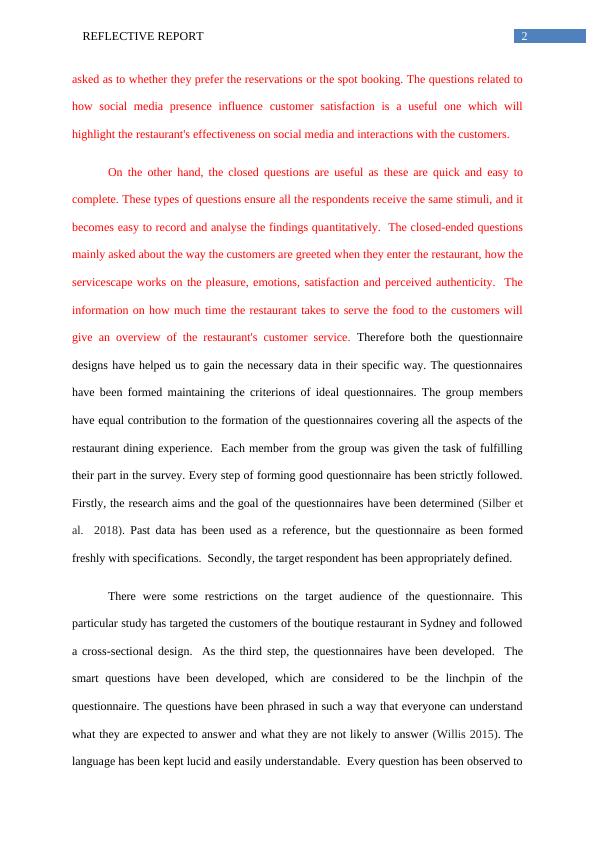Reflective Report on Questionnaire Design
Added on 2023-03-17
6 Pages1425 Words29 Views
Running Head : REFLECTIVE REPORT
Reflective Report
Name of the Student
Name of the University
Author Note
Reflective Report
Name of the Student
Name of the University
Author Note

1REFLECTIVE REPORT
Report
As evident from the above set of questionnaires, the primary purpose is to gather data
regarding the customer perceptions on the dimensions of servicescape, empathy, restaurant
authenticity in the dining experience of a restaurant. The objective is to gain better insight
into the relationships in the context of boutique restaurants in particular. It is the decisions of
the Restaurant and Catering Association of Australia to commission research on the above
mentioned factors. The questionnaires are highly crucial to gain several predefined answers
about the opinions, the experiences, the preferences, behaviours, intentions of a large group
of respondents (D'Ingianna et al. 2017).
It is to be noted that the questionnaire design is a multistage process which requires
distinct attention towards a wide range of aspects and it is more critical than the conduction
of a survey through the questionnaires. As found from the past studies, there are various
advantages of asking the right questions to the right persons. There are usually two types of
questionnaires, such as the open and the closed type of questions. The surveys designed for
this particular research have used both the open, and the closed format as both the types have
their benefits. The open form allows exploring the range of possible topics (Speight et al.
2016). The open questions arise from the research question and support the understanding of
the hypothesis. In the open-ended questions, we have asked the respondents about how they
felt the restaurant authenticity to be related to customer satisfaction. It is expected that there
will be a variety of questions. In the next few questions, their opinions regarding the
influence of restaurant attributes on the perceived authenticity of the restaurant have been
asked. These questions have been formed to know what are the customers’ viewpoint and
their demands from the restaurant they visit. It will provide information on how the boutique
restaurants are expected to behave; should they focus more on the guest experience, the
public image or the restaurant profit. In the third last question, the customer preference has
Report
As evident from the above set of questionnaires, the primary purpose is to gather data
regarding the customer perceptions on the dimensions of servicescape, empathy, restaurant
authenticity in the dining experience of a restaurant. The objective is to gain better insight
into the relationships in the context of boutique restaurants in particular. It is the decisions of
the Restaurant and Catering Association of Australia to commission research on the above
mentioned factors. The questionnaires are highly crucial to gain several predefined answers
about the opinions, the experiences, the preferences, behaviours, intentions of a large group
of respondents (D'Ingianna et al. 2017).
It is to be noted that the questionnaire design is a multistage process which requires
distinct attention towards a wide range of aspects and it is more critical than the conduction
of a survey through the questionnaires. As found from the past studies, there are various
advantages of asking the right questions to the right persons. There are usually two types of
questionnaires, such as the open and the closed type of questions. The surveys designed for
this particular research have used both the open, and the closed format as both the types have
their benefits. The open form allows exploring the range of possible topics (Speight et al.
2016). The open questions arise from the research question and support the understanding of
the hypothesis. In the open-ended questions, we have asked the respondents about how they
felt the restaurant authenticity to be related to customer satisfaction. It is expected that there
will be a variety of questions. In the next few questions, their opinions regarding the
influence of restaurant attributes on the perceived authenticity of the restaurant have been
asked. These questions have been formed to know what are the customers’ viewpoint and
their demands from the restaurant they visit. It will provide information on how the boutique
restaurants are expected to behave; should they focus more on the guest experience, the
public image or the restaurant profit. In the third last question, the customer preference has

2REFLECTIVE REPORT
asked as to whether they prefer the reservations or the spot booking. The questions related to
how social media presence influence customer satisfaction is a useful one which will
highlight the restaurant's effectiveness on social media and interactions with the customers.
On the other hand, the closed questions are useful as these are quick and easy to
complete. These types of questions ensure all the respondents receive the same stimuli, and it
becomes easy to record and analyse the findings quantitatively. The closed-ended questions
mainly asked about the way the customers are greeted when they enter the restaurant, how the
servicescape works on the pleasure, emotions, satisfaction and perceived authenticity. The
information on how much time the restaurant takes to serve the food to the customers will
give an overview of the restaurant's customer service. Therefore both the questionnaire
designs have helped us to gain the necessary data in their specific way. The questionnaires
have been formed maintaining the criterions of ideal questionnaires. The group members
have equal contribution to the formation of the questionnaires covering all the aspects of the
restaurant dining experience. Each member from the group was given the task of fulfilling
their part in the survey. Every step of forming good questionnaire has been strictly followed.
Firstly, the research aims and the goal of the questionnaires have been determined (Silber et
al. 2018). Past data has been used as a reference, but the questionnaire as been formed
freshly with specifications. Secondly, the target respondent has been appropriately defined.
There were some restrictions on the target audience of the questionnaire. This
particular study has targeted the customers of the boutique restaurant in Sydney and followed
a cross-sectional design. As the third step, the questionnaires have been developed. The
smart questions have been developed, which are considered to be the linchpin of the
questionnaire. The questions have been phrased in such a way that everyone can understand
what they are expected to answer and what they are not likely to answer (Willis 2015). The
language has been kept lucid and easily understandable. Every question has been observed to
asked as to whether they prefer the reservations or the spot booking. The questions related to
how social media presence influence customer satisfaction is a useful one which will
highlight the restaurant's effectiveness on social media and interactions with the customers.
On the other hand, the closed questions are useful as these are quick and easy to
complete. These types of questions ensure all the respondents receive the same stimuli, and it
becomes easy to record and analyse the findings quantitatively. The closed-ended questions
mainly asked about the way the customers are greeted when they enter the restaurant, how the
servicescape works on the pleasure, emotions, satisfaction and perceived authenticity. The
information on how much time the restaurant takes to serve the food to the customers will
give an overview of the restaurant's customer service. Therefore both the questionnaire
designs have helped us to gain the necessary data in their specific way. The questionnaires
have been formed maintaining the criterions of ideal questionnaires. The group members
have equal contribution to the formation of the questionnaires covering all the aspects of the
restaurant dining experience. Each member from the group was given the task of fulfilling
their part in the survey. Every step of forming good questionnaire has been strictly followed.
Firstly, the research aims and the goal of the questionnaires have been determined (Silber et
al. 2018). Past data has been used as a reference, but the questionnaire as been formed
freshly with specifications. Secondly, the target respondent has been appropriately defined.
There were some restrictions on the target audience of the questionnaire. This
particular study has targeted the customers of the boutique restaurant in Sydney and followed
a cross-sectional design. As the third step, the questionnaires have been developed. The
smart questions have been developed, which are considered to be the linchpin of the
questionnaire. The questions have been phrased in such a way that everyone can understand
what they are expected to answer and what they are not likely to answer (Willis 2015). The
language has been kept lucid and easily understandable. Every question has been observed to

End of preview
Want to access all the pages? Upload your documents or become a member.
Related Documents
Research Methodslg...
|4
|539
|58
Factors Affecting Behavioral Intention of Consumers in Boutique Restaurantslg...
|10
|1548
|319
Operationlg...
|36
|4236
|68
Report on Survey Questionnaire Developmentlg...
|8
|1502
|44
What Is Business Research? (With Methods and Examples)lg...
|8
|1510
|19
Designing a Survey Questionnaire: Best Practices and Recommendationslg...
|19
|5097
|89
